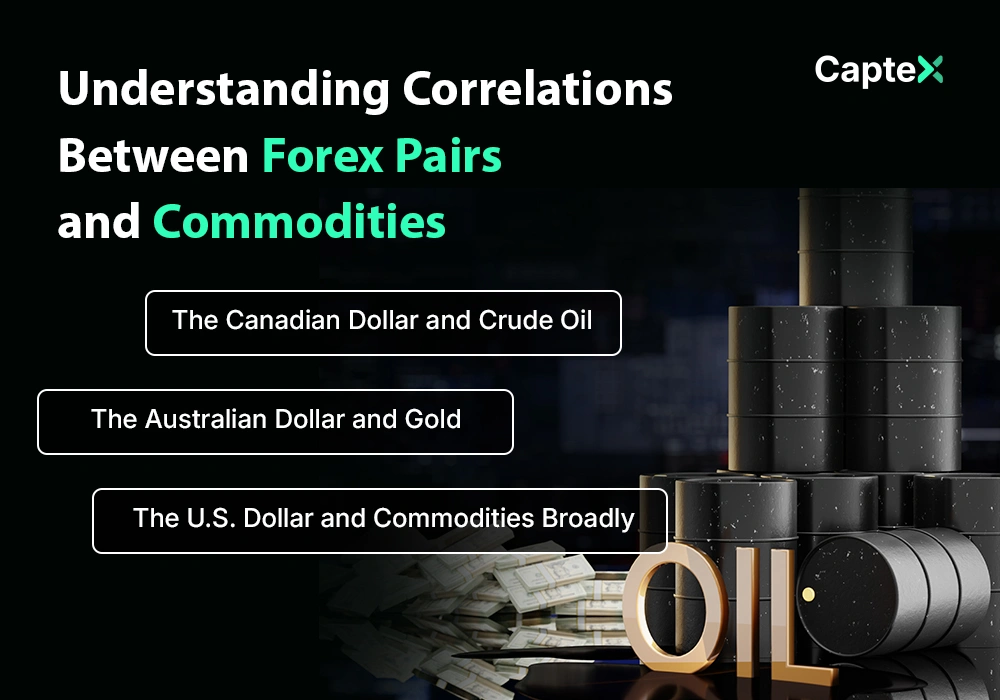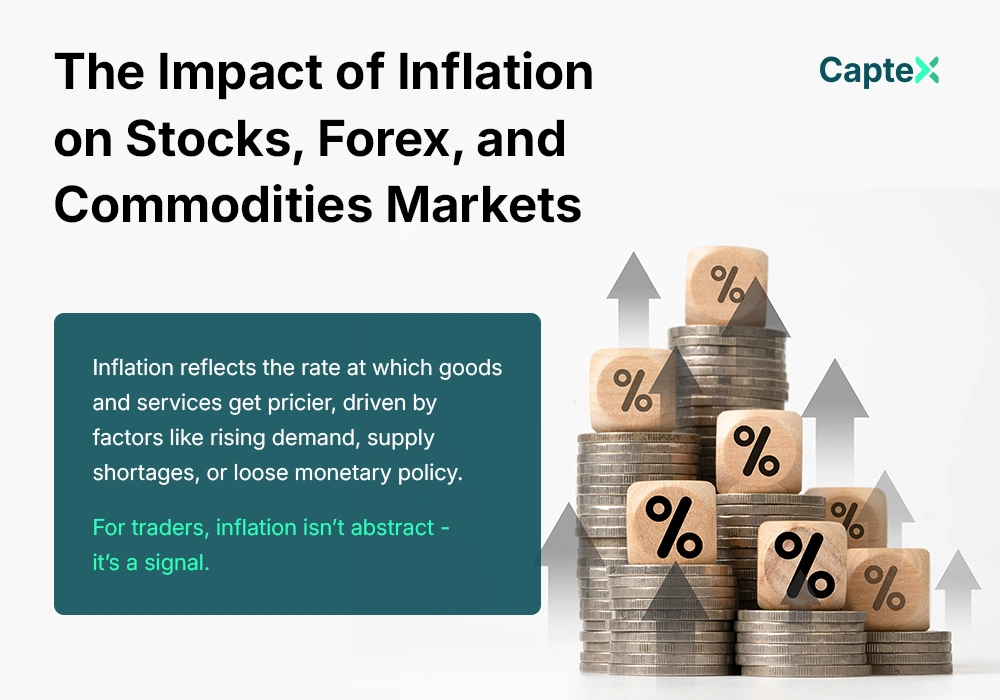Forex trading thrives on interconnected markets, and few relationships are as critical as the one between currency pairs and commodities. These correlations—where price movements in one asset influence another—offer traders a lens to predict trends, hedge risks, and spot opportunities. Whether it’s oil driving a currency or gold swaying a pair, understanding these links can sharpen your strategy. Let’s explore how forex pairs and commodities intertwine and how to use this knowledge effectively.

What Are Correlations in Trading?
Correlation measures how two assets move together, expressed as a value between -1 and 1. A positive correlation (near 1) means they rise or fall in sync; a negative correlation (near -1) means they move opposite; and near 0 suggests little connection. In forex and commodities, these ties stem from economic fundamentals—think supply chains, trade balances, or inflation pressures.
For traders, correlations aren’t static—they shift with market conditions. A currency tied to oil might soar during an energy boom but falter in a glut. Grasping these dynamics lets you anticipate price action, diversify trades, or double down on momentum. It’s less about guessing and more about decoding cause and effect.
The Canadian Dollar and Crude Oil
The Canadian dollar (CAD) and crude oil share one of the tightest correlations in forex. Canada’s a major oil exporter, so when oil prices climb—say, due to supply cuts or geopolitical tensions—CAD often strengthens. Pairs like USD/CAD reflect this inversely: rising oil weakens the pair (CAD gains on USD), while falling oil pushes it up.
Watch West Texas Intermediate (WTI) or Brent crude prices alongside USD/CAD. A surge past a key resistance, like $80 per barrel, might signal a CAD rally. But don’t assume it’s automatic—global demand, U.S. dollar strength, and seasonal factors can muddy the link. Use this correlation to confirm trades or hedge oil exposure with forex positions.
The Australian Dollar and Gold
Australia’s hefty gold exports tie its dollar (AUD) to the yellow metal. When gold prices rise—often during uncertainty or inflation fears—AUD tends to follow. AUD/USD is the pair to watch: a gold breakout above, say, $2,000 an ounce can lift it, while a slump might drag it down. The correlation isn’t as direct as CAD-oil, hovering around 0.5 to 0.8 historically, but it’s still potent.
Gold’s safe-haven status adds nuance. If stocks crash and gold soars, AUD might lag if Australia’s economy falters. Track gold futures and AUD/USD on daily charts, pairing them with economic data like mining output or Chinese demand (a big Aussie export market). It’s a slower burn than oil-CAD but rich with opportunity.
Factors influencing AUD-gold correlation:
- Global risk sentiment affecting gold demand.
- Australian mining production levels.
- Chinese economic growth driving commodity appetite.
- Interest rate differentials impacting AUD.
- U.S. dollar moves countering the trend.
The U.S. Dollar and Commodities Broadly
The U.S. dollar (USD) casts a wide net over commodities, thanks to its role as the world’s reserve currency. Most commodities—oil, gold, copper—are priced in USD, creating an inverse dance. When USD strengthens, commodities get pricier for non-U.S. buyers, often cooling demand and prices. A weak USD does the reverse, lifting commodity values.
Pairs like USD/JPY or EUR/USD reflect this. A USD rally might tank gold, pushing EUR/USD higher as the euro gains. Oil’s USD link hits USD/CAD too. Monitor the U.S. Dollar Index (DXY) against commodity indices—rising DXY often signals a forex shift. This broad correlation is your macro compass for timing trades.

Gold and Safe-Haven Currencies
Gold’s safe-haven allure ties it to currencies like the Japanese yen (JPY) and Swiss franc (CHF). During crises—think wars or market panics—investors pile into gold, yen, and franc, driving up pairs like USD/JPY (inversely) or USD/CHF. The correlation isn’t perfect—JPY and CHF also lean on low interest rates—but it spikes when fear rules.
Check gold versus XAU/USD (gold in USD terms) and USD/JPY. A gold surge past $2,100 might sink USD/JPY as yen strengthens. Use this to hedge risk-off moves or ride momentum in tandem. Economic calendars highlighting risk events—like central bank decisions—amplify these shifts.
Commodity Currencies Beyond Oil and Gold
Other forex-commodity pairs deserve attention. The New Zealand dollar (NZD) tracks dairy and agricultural goods—milk powder price jumps lift NZD/USD. South Africa’s rand (ZAR) hinges on platinum and gold, with USD/ZAR dipping when metals shine. Norway’s krone (NOK) rides oil waves, mirroring CAD’s playbook.
These “commodity currencies” thrive when their exports boom. A drought slashing dairy output might tank NZD, while a platinum mine strike could juice ZAR. Dig into trade data and commodity reports—say, USDA crop updates or OPEC bulletins—to spot catalysts. These pairs offer niche plays for savvy traders.
Commodity currency drivers:
- Export volumes and global demand shifts.
- Weather impacting agricultural yields.
- Mining disruptions or labor strikes.
- Trade policies altering supply chains.
- Currency-specific economic policies.
Using Correlations to Hedge Risks
Correlations aren’t just for predicting—they’re hedging goldmines. If you’re long oil futures and see prices slipping, shorting USD/CAD can offset losses as CAD weakens. Or, if you’re bullish on AUD/USD but gold’s shaky, a small gold short might balance the risk. The negative or positive link guides your counter-move.
Calculate position sizes based on correlation strength—use a tool like a correlation coefficient (available on most platforms) to quantify it. A 0.8 link demands tighter alignment than a 0.3 one. Test hedges in a demo account first; misjudging the tie can amplify losses instead of cushioning them.
Trading Strategies with Correlations
Turn correlations into trades with a plan. For trend-following, ride CAD strength with oil upticks—buy CAD/JPY when crude breaks out, using moving averages for confirmation. For reversals, fade overbought gold by shorting AUD/USD when RSI hits 70. Range traders can play USD/CAD’s oil-driven swings between support and resistance.
Layer in fundamentals—OPEC meetings, Fed rate hikes—to time entries. Technicals like Bollinger Bands or Fibonacci retracements refine your spots. Keep an eye on correlation shifts; a sudden USD rally can flip the script. Flexibility and discipline make these strategies click.
Limitations of Correlation Trading
Correlations aren’t foolproof. They weaken during chaos—say, a pandemic scrambling trade norms—or when unrelated factors (like a surprise rate cut) dominate. Lags happen too; oil might jump, but CAD drags if U.S. data overshadows it. Overreliance risks blindsiding you to exceptions.
Mitigate this by cross-checking with volume, sentiment, and news. A correlation below 0.6 signals caution—don’t force the trade. Diversify across pairs and assets to avoid betting the farm on one link. It’s a tool, not a crystal ball—use it wisely.
Bottom Line
Mastering correlations between forex pairs and commodities unlocks a deeper market edge. CAD rides oil, AUD tracks gold, USD steers the broader ship, and safe-haven pairs dance with precious metals. These ties offer predictive power, hedging options, and strategic plays—if you respect their limits. Blend them with technicals and news, and you’ll trade not just prices, but relationships. In forex’s global web, that’s where the real wins hide.





